I traveled around Luxembourg, the first country in the world to make public transport free, by train, tram, and bus. Here's what it was like.
Mikhaila Friel

- I visited Luxembourg, the wealthiest country in the world, where public transport is free.
- I explored the city and countryside using the tram, train, and bus services.
Last week, I visited Luxembourg, the wealthiest country in the world, where public transport is completely free.
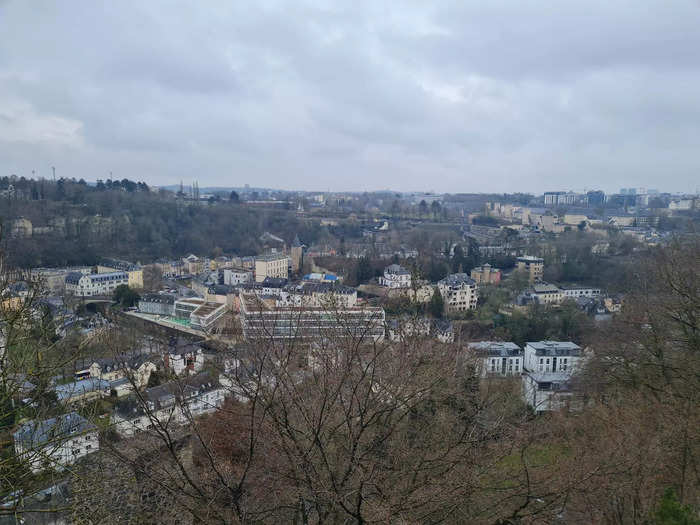
Last week, I traveled from my home in Scotland, UK, to Luxembourg, a small landlocked European nation that has 645,000 residents, a spokesperson for Visit Luxembourg confirmed to Insider.
It's also the wealthiest country in the world, according to an August 2022 report by Global Finance, which analyzed the gross domestic product (GDP), meaning the value of all goods and services produced by the nation.
I'd been eager to visit Luxembourg ever since it became the first country in the world to make public transport free in February 2020.
Luxembourg shares borders with Belgium, France, and Germany, and is best known for its beautiful countryside and historic castles.
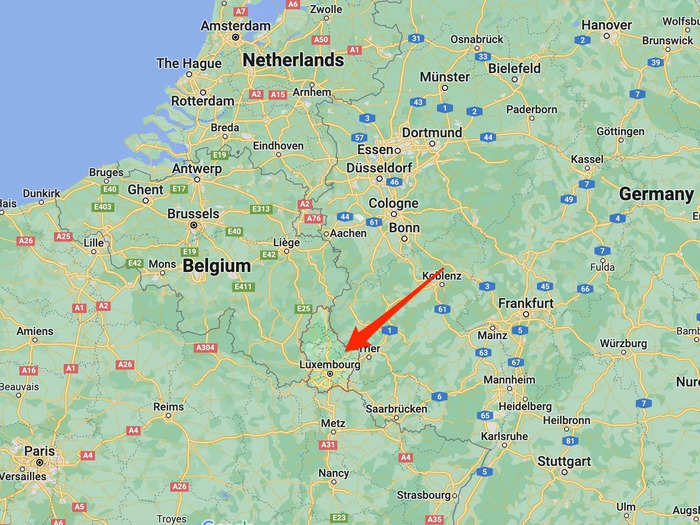
Trains, trams, and buses in Luxembourg are free of charge to both residents and visitors as part of the government's plan to support people living on lower incomes, a spokesperson for the government's mobility department told Insider during my visit.
I spent $0 on transport while traveling around Luxembourg City and the countryside.
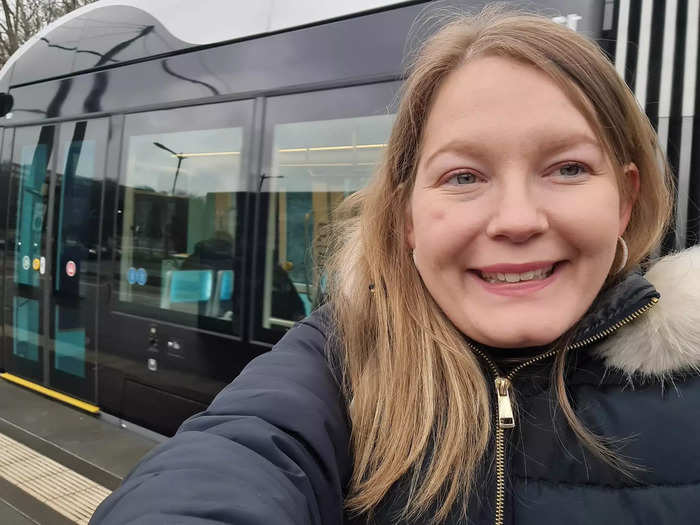
During my three-day visit, I spent a day in Luxembourg City, the country's capital and only city, which I navigated by foot and using the city's tram system. Then, I traveled to Clervaux in the countryside using the train and bus ahead of a two-night stay at Chateau d'Urspelt, a 13th-century castle that was transformed into a spa hotel in 2008.
Here's what using the free public transport was like.
My journey began at Luxembourg Airport on Sunday, March 5, where there was a free shuttle bus waiting to take people to the city.
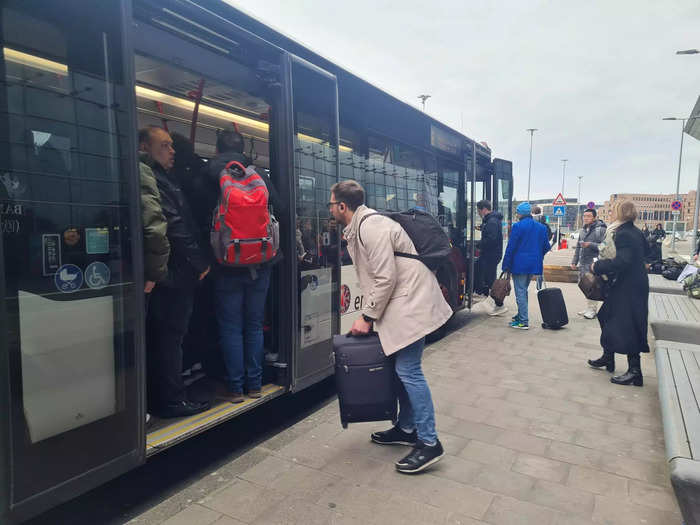
Before my flight from Edinburgh to Luxembourg on March 5, I researched the airport's shuttle bus system online. According to the airport's official website, there are free daily shuttle buses to and from the city every 10 minutes on weekdays, every 20 minutes on Saturdays, and every 30 minutes on Sundays. There are also bus services to and from various locations in France, Belgium, and Germany, according to the website.
I used the Citymapper app on my phone to find out which service I needed to take, and luckily enough, it was easy to get to. As soon as I left the terminal, I spotted the bus parked across the street.
The bus was extremely busy, and I ended up having to stand.
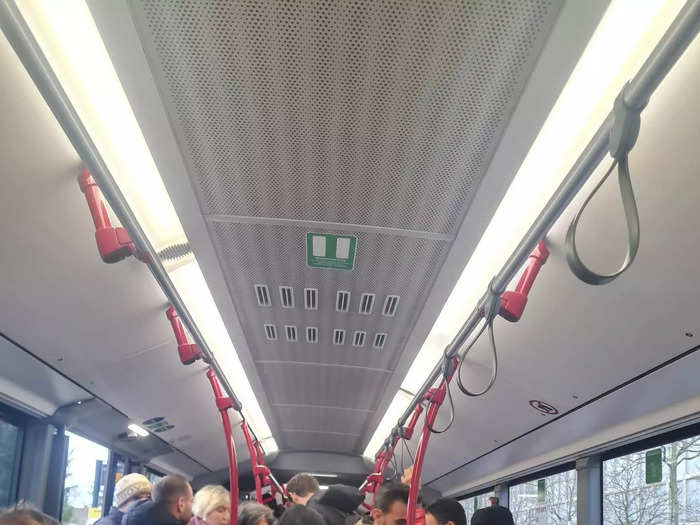
I was one of the last people to get on the bus, and all the seats were taken during the 20-minute journey to the city center.
I had assumed that even though there was no ticket requirement for the bus, the driver would still cap the number of people that he allowed on board, but this didn't seem to be the case.
I could hardly move because of how busy it was in the aisle.
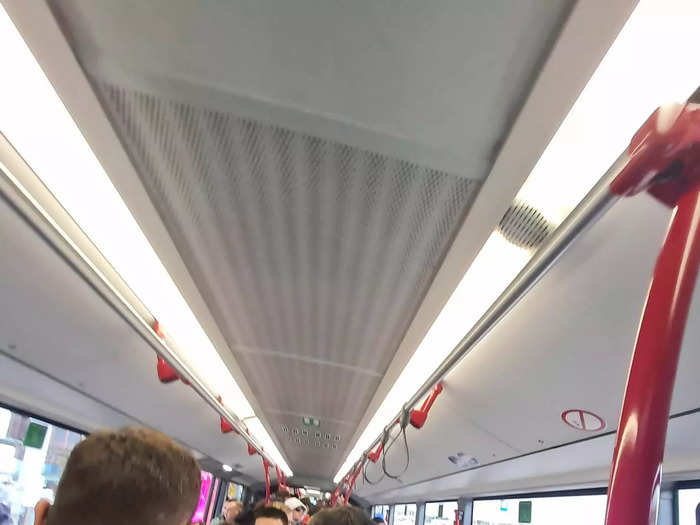
There were luggage shelves above the seats for people to store their suitcases, but no luggage racks for larger items. I noticed that some people used the seat next to them for their suitcase, which I thought wasn't ideal considering how many people were left standing in the aisle.
While I appreciated that the bus journey was free and services are less frequent on Sundays, which is when I was traveling, it would likely be more efficient and safer if the airport started using a free ticketed system to avoid overcrowding like this.
The bus dropped me off around the corner from Hotel Le Royal, a five-star hotel where I had booked a room for the night.

I got off the bus in the city center and then walked for five minutes to Hotel Le Royal, a five-star hotel where I was staying overnight.
I stayed in a traditional queen room, which cost $275.70 for one night and had a queen-sized double bed, a TV, a dressing table, and a bathroom with a bath and shower. There was also a complimentary fruit bowl and a box of chocolates in my room upon my arrival.
I was surprised by the vast amount of cars parked on the street close to the hotel.
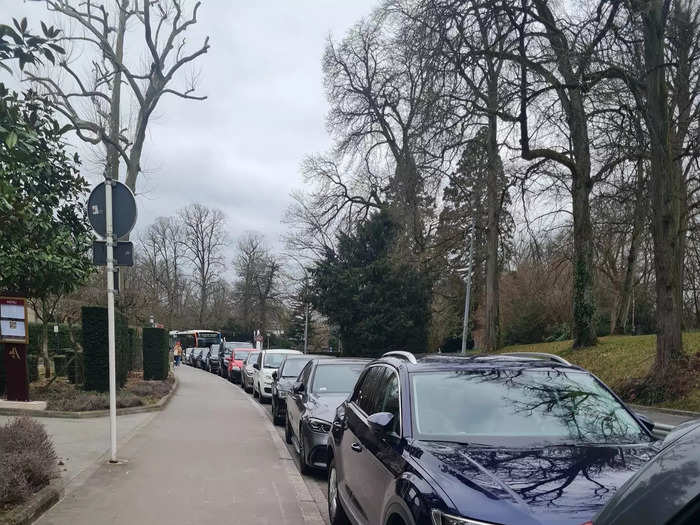
I had assumed that the country's free public transport initiative meant people would be less likely to drive in the city; however, I noticed a substantial number of cars parked on the streets and driving on the roads.
The next day, I decided to take the tram to some of the city's landmarks that I had researched online.
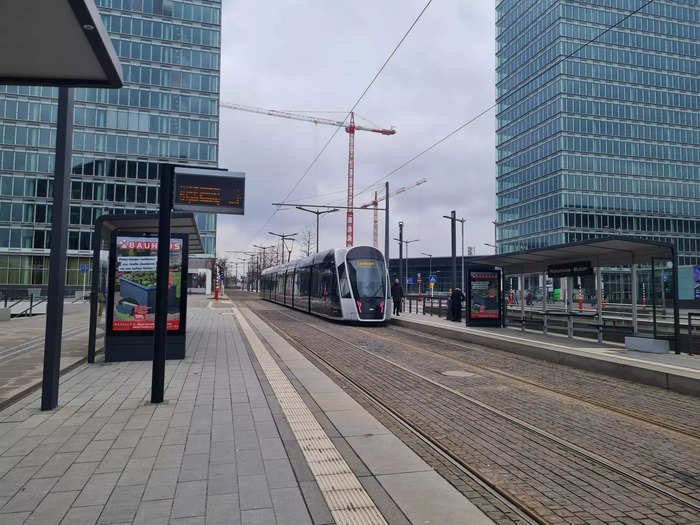
The Luxembourg tram has one line with 17 stops, according to the Ville De Luxembourg website.
I started my journey just after 11 a.m. at the Limpertsberg tram stop in the northwest of the city, which was around a 15-minute walk from the hotel. While I waited for the tram to Kirchberg in the northeast of the city to arrive, I noticed that the platform was incredibly clean and there were digital boards that clearly displayed departure times and destinations. There weren't many people waiting for the tram, but I assumed this was because it was an off-peak time on a Monday.
I was surprised by how much space there was inside the tram.
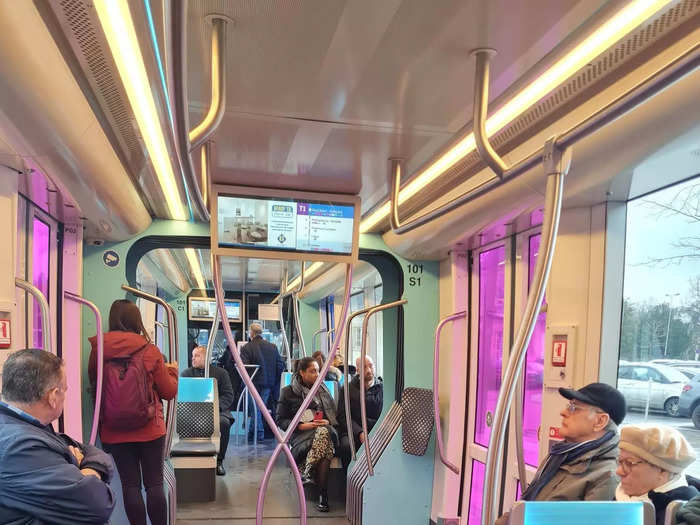
The tram had plenty of seats spaced out across multiple carriages, including designated seats for the elderly and pregnant people.
There were also hand grips for those standing, and I noticed that many people chose to stand rather than sit, even though the tram was quiet and there there were empty seats.
There were no luggage shelves or storage space for bags.
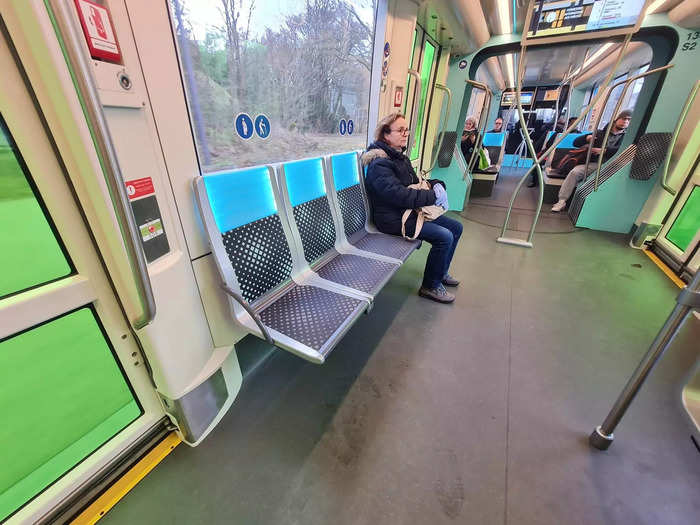
While there were no luggage shelves or storage spaces on the tram, there was plenty of open space next to the chairs so I don't imagine there would be an issue for those taking the tram after arriving from the airport.
Like many others, I decided to stand and found it to be a comfortable experience.
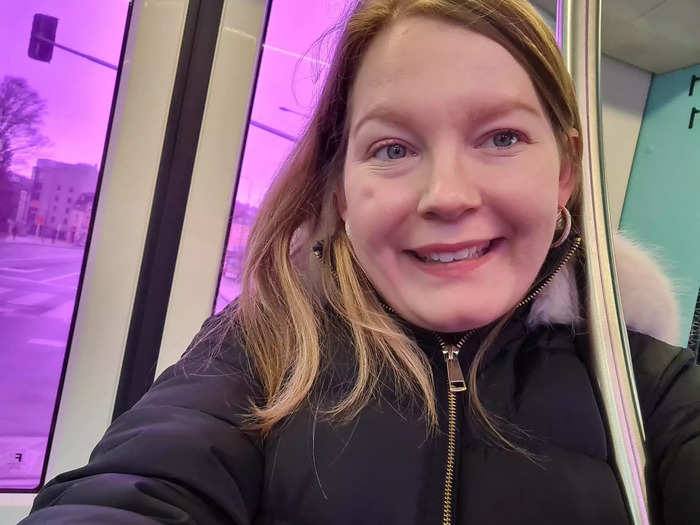
Since I was only planning to be on the tram for a short time, I decided to stand and held on to the pole next to the window. This also meant I had a good view of the city during the journey.
There were digital screens in each carriage displaying the various stops.
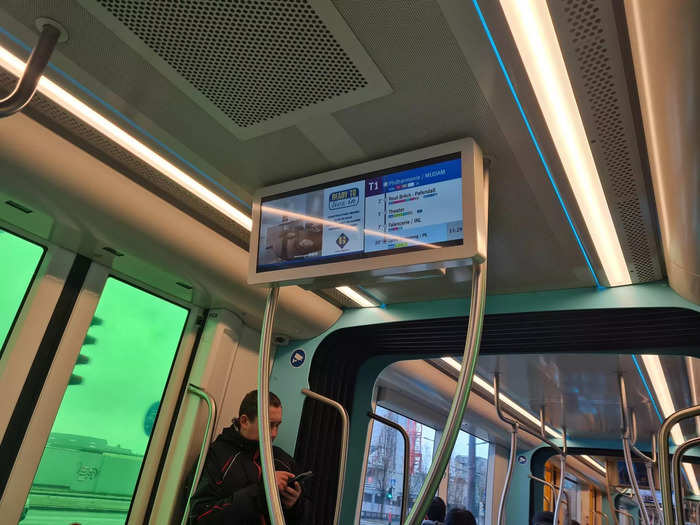
I originally intended to take the tram for three minutes to Kirchberg, as there was a lookout spot with spectacular views of the city that I had read about online.
But after reading the digital board in the carriage, I realized that this tram also stopped at the European Parliament's Luxembourg branch. I decided to stay on a little longer — around 10 minutes — to the parliament and then visit the lookout point on the way back.
I got off the tram at a stop that was directly across the street from the European Parliament building.
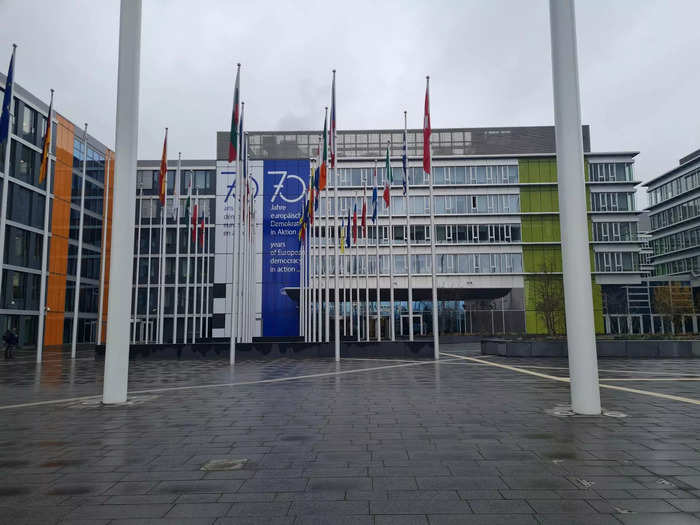
Luxembourg is a founding member of the European Union, an international organization that allows for the free movement of goods, capital, and services for the 27 European countries which are members, according to the UK Government website.
Luxembourg is also home to one branch of the European Parliament, which has a number of democratic responsibilities, including passing EU laws, and democratic scrutiny of all EU institutions, according to the EU website. There are two other branches in Strasbourg, France, and Brussels, Belgium, the website states.
While it's possible to arrange free tours of the parliament, these can only be arranged for groups of 20 to 50 people and should be booked two weeks in advance, according to the European Parliament website. Therefore, I settled for seeing the exterior of the building.
I was thankful that I didn't need a ticket for the tram, as it meant I could hop on and hop off whenever I liked.
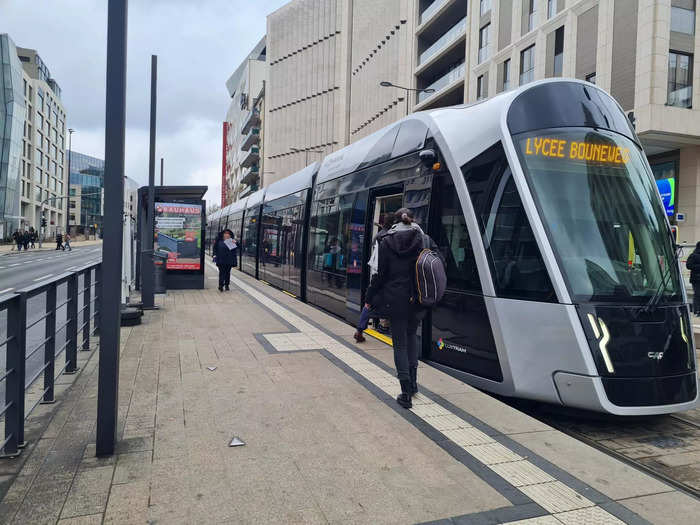
After looking at the parliament building, I got back on the tram to travel to the lookout point at Park Drai Eechelen.
This time around, I decided to take a seat in the middle of the carriage.
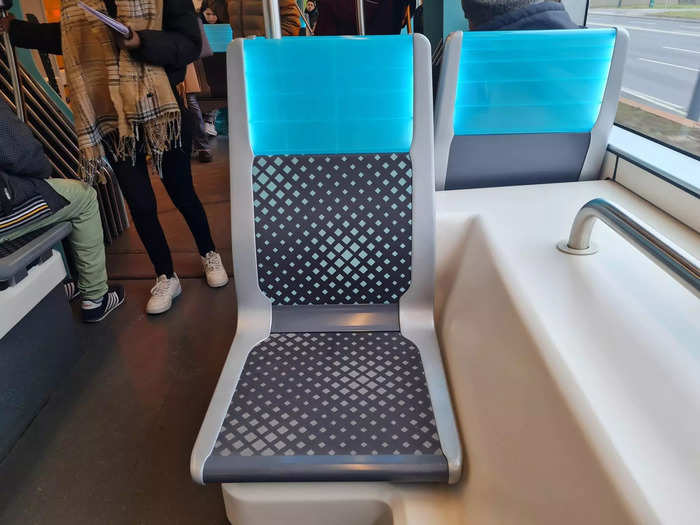
The number of seats in the carriage seemed to have no particular order; there were seats of two, rows with multiple seats, and singular seats facing other singular seats.
The next tram I went on was a little busier, so I chose the single seat that was directly across from another single seat. I found it a little awkward, as there was another passenger sitting in the seat across from me and there wasn't enough legroom for the both of us; I ended up twisting my body around and positioning my feet in the aisle. Luckily, the journey to Kirchberg lasted only a couple of minutes.
It took around three minutes on the tram to Kirchberg, and then I walked for eight minutes to Park Drai Eechelen.
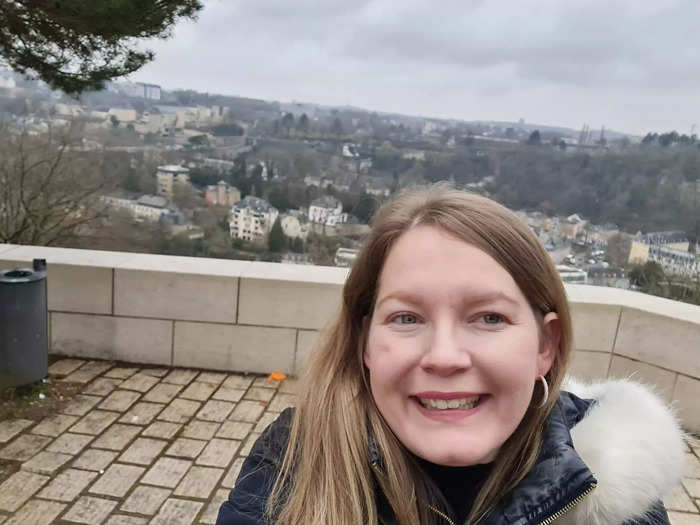
I walked to Park Drai Eechelen, a public park just outside of the city center that has panoramic views of the city. The area was almost empty of people, and I thoroughly enjoyed taking photos of the beautiful scenery.
While the tram was useful, I found that most places in Luxembourg City were walkable thanks to its small size as well as an elevator that connects the upper and lower levels of the city.
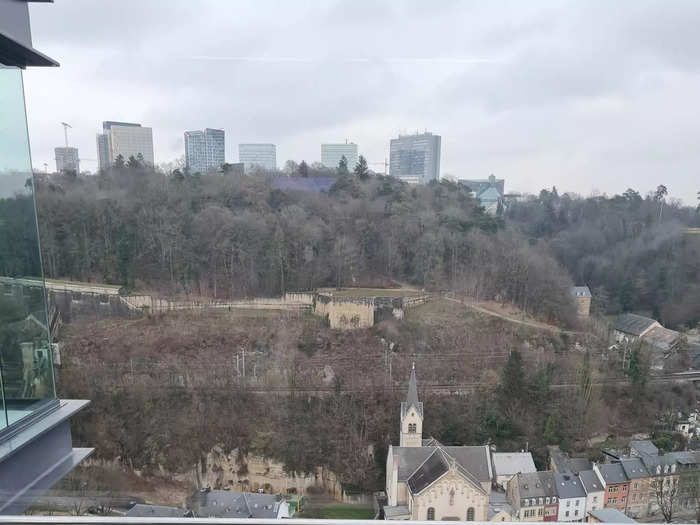
Later in the day, I visited historic landmarks including the Grand Ducal Palace, the Grand Duchess Charlotte Bridge, and the Grund Quarter, which is accessible using stairs or an elevator with panoramic views of the city. Outdoor elevators that aren't part of buildings aren't common in the UK, so I was excited to see this in Luxembourg.
I found that most places I visited were accessible by foot because of the city's small size. That being said, I can imagine the tram coming in handy on days when the weather is particularly dreary or to cut down a long trip where there's a lot of walking required.
Later that evening, I embarked on a journey from the city to Clervaux in the countryside via train.
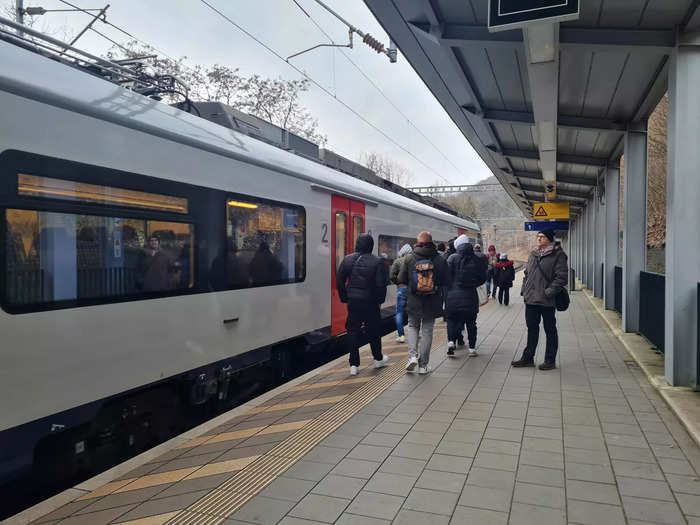
After checking out of Hotel Le Royal, I made my way to Pfaffenthal-Kirchberg train station to board my train to Clervaux, where I would be staying for two nights in Chateau d'Urspelt. Pfaffenthal-Kirchberg isn't the main train station in Luxembourg (that would be Gare Central), but it was the closest train station to the hotel and I was able to walk there in around 13 minutes.
The journey to Clervaux was due to take just over an hour, with one transfer at Ettelbruck.
The interior of the train had plenty of seats and luggage shelves.
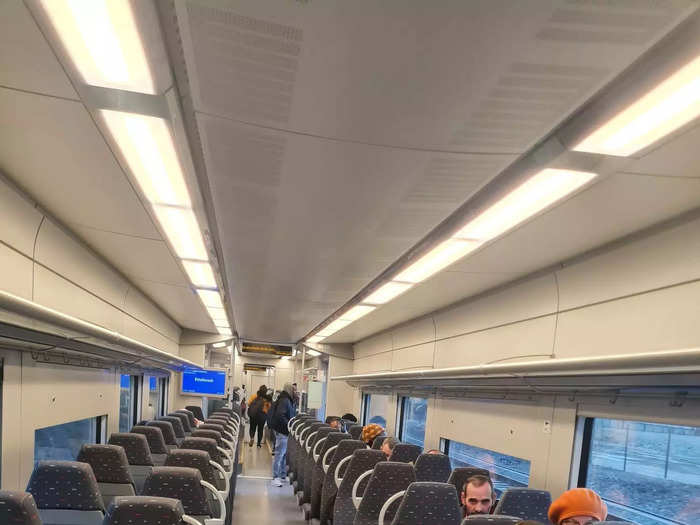
The train had luggage shelves above the seats, and a trash can at the end of the carriage.
I noticed there wasn't a dining car or power outlets to charge electronic devices, which I thought was likely due to the fact that the journey was so short.
I chose a seat by the window.
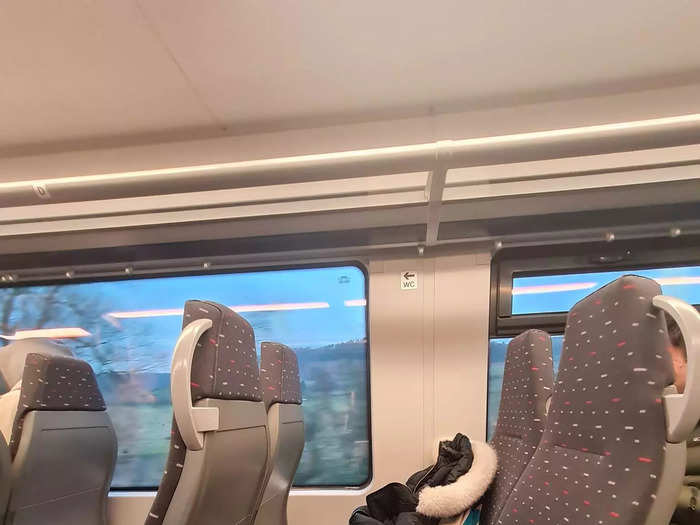
The seat itself was soft and comfortable. However, unlike some trains that I've been on in the UK and Europe, there were no tray tables on the back of the seats.
I got to enjoy views of the Luxembourg countryside during the first train journey, which took approximately 20 minutes.
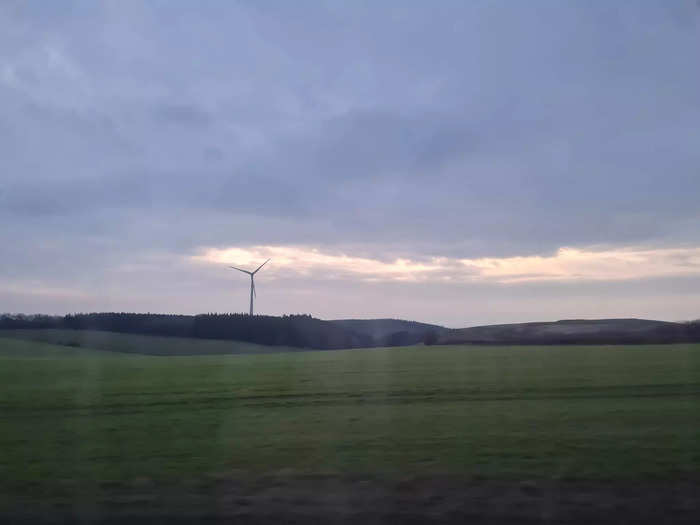
There were only two stops on my first train to Ettelbruck, and since I was in a window seat I was able to enjoy views of the surrounding fields and greenery.
About halfway through the journey, a member of staff walked down the aisle of the train. I instantly thought of getting my ticket ready, only to remember that I didn't have a ticket and the journey was free.
My connecting train from Ettelbruck to Clervaux was canceled, but there was a replacement bus waiting outside the train station.
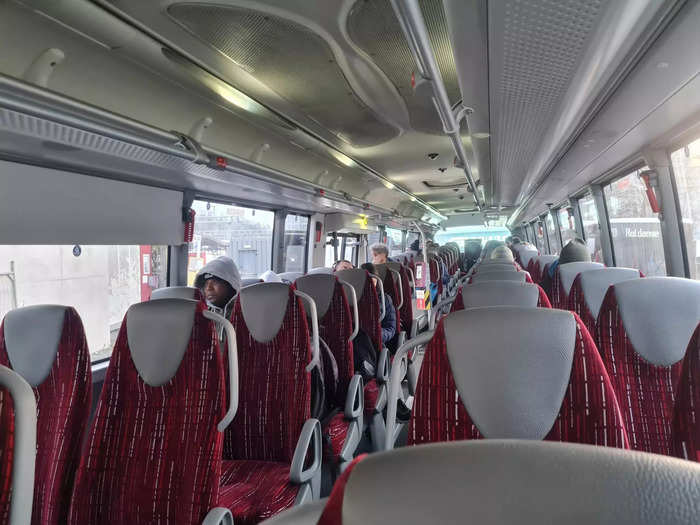
I didn't realize when looking at my Citymapper app that the train service had been canceled due to maintenance works; however, there was a sign outside the station explaining that there would be a replacement bus service to Clervaux.
I chose a window seat directly behind the driver.
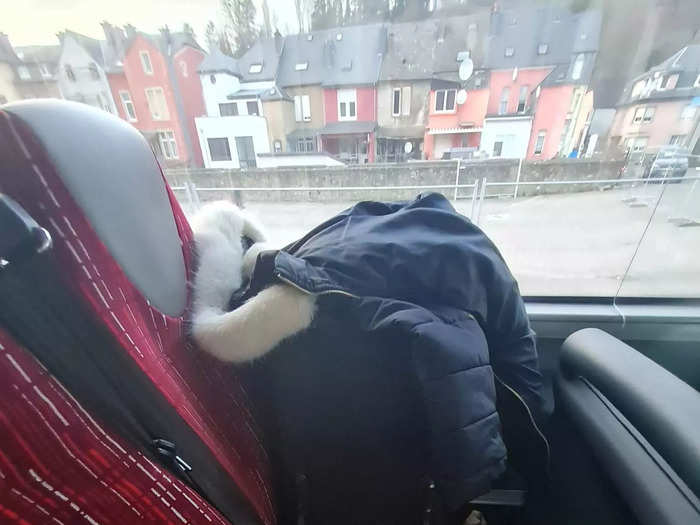
There were luggage racks above the seat, however, I struggled with being able to lift my belongings so I kept them on the seat next to me during the journey. The bus wasn't busy, so I felt comfortable doing this.
I sat behind the driver, with the hopes that I could ask him any questions if I wasn't sure what stop to get off at. But this wasn't necessary — there was a digital screen overhead that showed which stops were left on the journey and the remaining time to each stop.
The journey took 49 minutes and was very relaxing thanks to the comfortable seat.
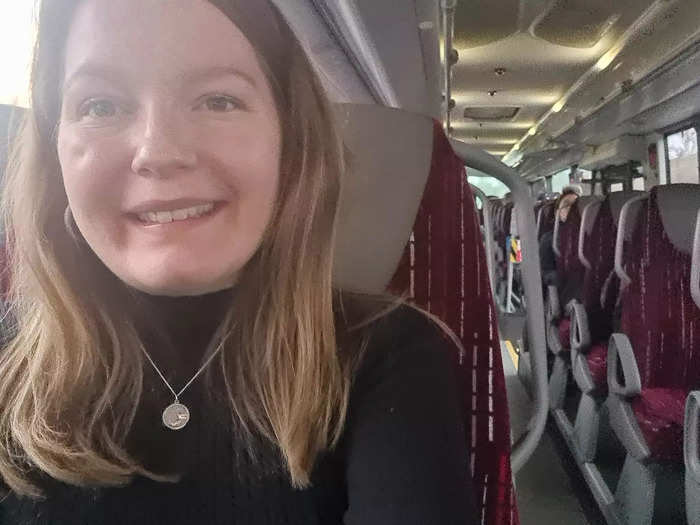
The seat was comfortable and it had a padded headrest. There was also a power outlet beside my seat, which I thought was useful.
The hotel, Chateau d'Urspelt, was a seven-minute drive or a 37-minute walk from Clervaux train station.
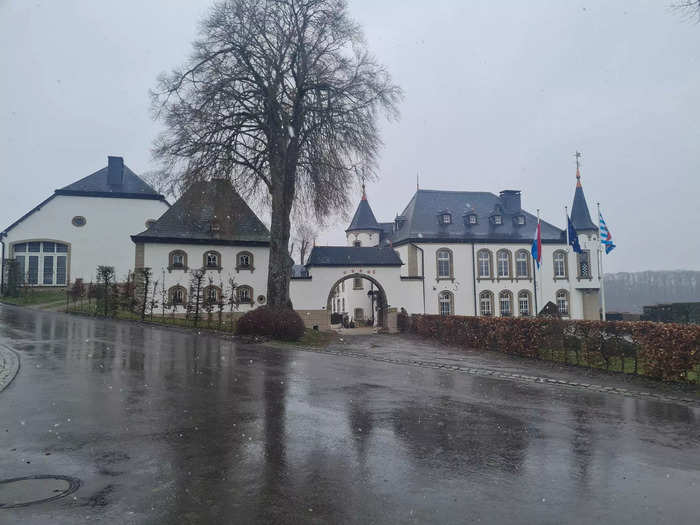
Soon, the bus arrived in Clervaux, a town in the countryside that's known for its gorgeous scenery and fairytale castles. Luckily, Chateau d'Urspelt was just a short drive from the train station and the hotel manager, Yannick Ruth, was kind enough to pick me up in his car.
It was a fantastic way to end my day of traveling around Luxembourg, and I was shocked at how easy and comfortable it was for an outsider like myself to navigate the public transport system.
Luxembourg's free public transport system was a great incentive for my visit, and I wish more countries around the world followed this example.
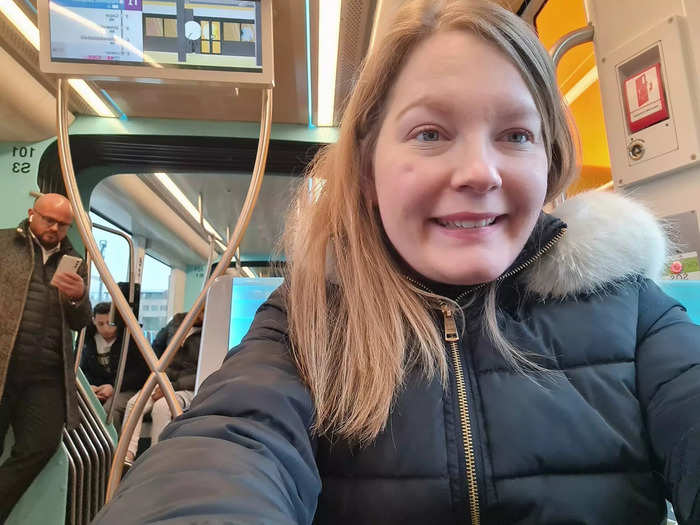
The free public transport was one of the major reasons for my visit to Luxembourg, and I wasn't disappointed. I was able to enjoy traveling around the city and the countryside without worrying about how much money I was spending on train and bus fares. Not to mention, public transport is far better for the environment than driving or taking a taxi.
And it seems that Luxembourg is setting the example. As of September 2022, more than 50 cities and towns across Europe have introduced free public transport, citing the environment and social equality as reasons for doing so, according to Euro News. My only wish is that more countries implement free public transport on a nationwide level.
Popular Right Now
Popular Keywords
Advertisement